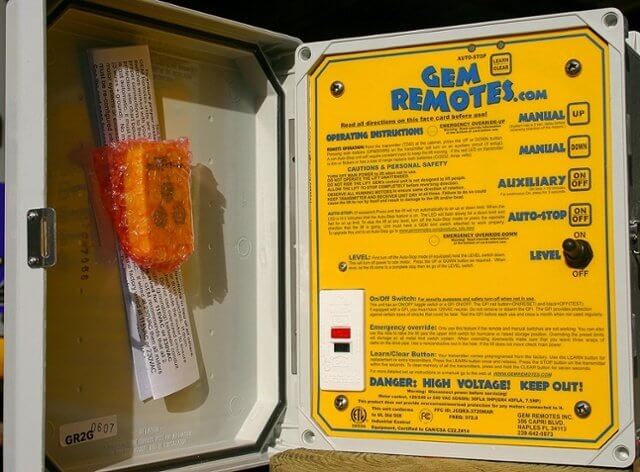To stop engine spin during harmonic balancer removal, use a strap wrench or a flywheel holding tool. Secure the engine flywheel or pulley before loosening the balancer bolt.
Removing a harmonic balancer is a critical task that requires the right approach and tools to prevent engine rotation. This process is often necessary during engine repair or when servicing the drive belts. The harmonic balancer, also known as the crankshaft pulley, is connected directly to the engine’s crankshaft.
It plays a crucial role in reducing engine vibration and keeping the belts running smoothly. Mechanics typically secure the engine’s flywheel or use a specialized tool to immobilize the pulley. This allows for the safe and effective removal of the balancer without causing damage to the engine. Ensuring the engine remains stationary not only facilitates a smoother repair process but also prevents potential hazards associated with unintentional movement.
Introduction To Harmonic Balancer Removal
Removing a harmonic balancer is a critical task. It demands precision and understanding. This component, crucial for engine health, needs careful handling. Learn the process and tackle common challenges with ease.
The Role Of A Harmonic Balancer
A harmonic balancer keeps engine vibrations in check. It helps maintain crankshaft stability. This part extends the life of engine components. Think of it as a shield against premature wear.
Common Challenges In Removal
Extracting a harmonic balancer presents obstacles. Rust and tight fits are typical. Special tools may be necessary. Avoid engine spin during removal. This ensures a safe and successful task.
- Corrosion: Rust can fuse the balancer to the crankshaft.
- Space Constraints: Limited room complicates tool use.
- Engine Movement: It can spin without proper locking.
Tools You’ll Need
Before diving into removing a harmonic balancer, gather the right tools. This makes the job easier and safer. Let’s look at the essentials.
Essential Equipment
- Socket Wrench Set: For loosening and tightening bolts.
- Harmonic Balancer Puller: A special tool for this task.
- Breaker Bar: Adds leverage to turn tight bolts.
- Torque Wrench: Ensures bolts are properly tightened.
Safety Gear
- Gloves: Protect hands from sharp parts and grease.
- Safety Glasses: Keep eyes safe from flying debris.
With these tools and safety gear, you’re ready to start. Each item helps make the job smooth and keeps you safe. Remember, the right tools turn tough tasks into easy ones.
Preparation Steps
Before removing a harmonic balancer, proper preparation is crucial. This ensures a smooth process and prevents engine damage. Follow these essential steps to prepare:
Vehicle Safety
- Park on a flat surface.
- Use wheel chocks to secure the vehicle.
- Engage the parking brake.
- Disconnect the battery to avoid accidents.
Engine Positioning
Ensuring the engine is correctly positioned is vital. Follow these steps:
- Set the gear to neutral.
- Locate the crankshaft pulley for access.
- Mark the current position of the engine components.

Credit: www.reddit.com
Securing The Engine
Before removing a harmonic balancer, secure the engine properly. This prevents unwanted movement. Let’s explore the steps.
Wheel Chocks And Brakes
First, ensure the vehicle doesn’t roll. Place wheel chocks behind the wheels. Engage the parking brake firmly. This stabilizes the car.
- Position chocks snugly against wheel treads.
- Apply the brake to its highest point.
Transmission Locking
Next, lock the transmission. This halts engine rotation. Use the following method:
- Set the transmission to ‘Park’ for automatics.
- Choose a low gear in manual cars.
Now, the engine is ready. You can safely remove the balancer.
Stopping Engine Spin
Stopping Engine Spin is key during harmonic balancer removal. This process prevents damage and ensures safety. Let’s explore effective methods to achieve this.
Flywheel Locking Techniques
Locking the flywheel stops the engine from spinning. It’s a safe method. Here are steps and tools needed:
- Use a flywheel locking tool. It fits between the engine and transmission.
- Remove the starter to access the flywheel area.
- Insert the tool to lock the flywheel in place.
This method is direct and avoids engine damage.
Alternative Methods
If a flywheel locking tool is not available, try these:
- Chain Wrench: Wrap it around the balancer, securing it firmly.
- Strap Wrench: Another option to hold the balancer in place.
- Manual Hold: Have a helper hold the crank pulley with a suitable tool.
These methods require care to avoid injury or damage.
Removing The Harmonic Balancer
The harmonic balancer plays a vital role in your engine’s performance. Removing it requires precision and care. This guide provides a clear, step-by-step process for safely removing the harmonic balancer. Troubleshooting tips help address common challenges.
Step-by-step Process
Tools and preparation are crucial. Gather all necessary equipment before starting. This includes a socket set, puller tool, and safety gear.
- Disconnect the battery. Ensure the vehicle is off and keys removed.
- Locate the harmonic balancer at the front of the engine crankshaft.
- Remove any components obstructing access. This may include the radiator fan or drive belts.
- Loosen the crankshaft bolt. Use a breaker bar for added leverage.
- Attach the puller tool. Ensure it’s seated properly on the balancer.
- Turn the puller’s bolt. This will slide the balancer off the crankshaft.
Troubleshooting Tips
- If the balancer won’t budge, check the puller’s alignment.
- Penetrating oil can help loosen a stuck balancer.
- Never force the balancer. This can cause damage.
- Ensure the crankshaft bolt is completely loose.
- Review the vehicle’s manual for specific tips.
After Removal
Removing the harmonic balancer is a critical step in engine maintenance. It’s now time to inspect and care for the parts. Proper inspection and maintenance ensure longevity and optimal performance.
Inspection Of Parts
Every part demands thorough inspection once you remove the harmonic balancer. Begin with the balancer itself. Check for cracks, wear, or any signs of damage. Inspect the crankshaft end for signs of wear or scoring. Pay close attention to the keyway and threads. Ensure all removed parts are free of defects and fit for reuse.
Cleaning And Maintenance Tips
Clean parts promise better performance and longevity. Use a degreaser to clean the harmonic balancer. A soft cloth or brush works best. Clean the crankshaft surface with care. Avoid abrasive materials that can cause damage.
- Apply lubricant to the crankshaft snout.
- Replace any worn seals or parts before reassembly.
- Consult the service manual for specific maintenance tips.

Credit: www.reddit.com
Reassembly And Testing
With the harmonic balancer off, engines await reassembly. Precision is key. Now, let’s focus on putting things back together and checking our work.
Reinstalling The Harmonic Balancer
Reinstalling the harmonic balancer starts with preparation:
- Inspect the balancer for damage.
- Lubricate the crankshaft and balancer hole.
- Align the keyway and slot.
Next, follow these steps:
- Slide the balancer onto the crankshaft.
- Use the installation tool to prevent damage.
- Tighten the central bolt to manufacturer specs.
Engine Testing Procedures
After reassembly, engine testing ensures success:
| Step | Action |
|---|---|
| 1 | Check for leaks and alignment. |
| 2 | Reconnect battery and start the engine. |
| 3 | Listen for unusual noises. |
| 4 | Monitor engine performance and vibration. |
Finalize with a road test. Smooth operation means success.
Professional Help
Removing a harmonic balancer is tricky. Sometimes, engines spin unexpectedly. This can be risky. Professional help ensures safety and efficiency.
When To Seek A Mechanic
Not all car problems are DIY-friendly. A spinning engine during maintenance is serious. Mechanics have the right tools and skills. They stop the spin safely. Seek a mechanic if you:
- Lack proper tools
- Feel unsure about the process
- Want guaranteed safety
- Value your time
Costs And Considerations
Costs vary for professional services. Factors include:
| Service Type | Cost Range |
|---|---|
| Inspection | $50-$100 |
| Removal | $200-$400 |
| Replacement | $400-$600 |
Consider the mechanic’s experience. Also, the car’s make and model. Remember, quality service saves future costs. Choose a reputed mechanic for the best results.
Maintenance To Prevent Future Issues
Keeping your car running smoothly requires regular maintenance. One key area often overlooked is the harmonic balancer. This component helps reduce engine vibration. Without proper care, you might face a tricky situation like the engine spinning when removing the harmonic balancer. Let’s dive into maintenance tips to prevent future issues.
Regular Check-ups
Regular check-ups are crucial for a healthy car. They ensure all parts, including the harmonic balancer, work well. Here are steps to keep your engine happy:
- Schedule regular inspections with a trusted mechanic.
- Look for signs of wear and tear on the harmonic balancer.
- Listen for unusual noises that could indicate a problem.
Harmonic Balancer Care Tips
Taking care of your harmonic balancer extends its life. Follow these tips:
- Avoid harsh driving conditions when possible.
- Use the right tools for maintenance and repairs.
- Replace the harmonic balancer if it shows signs of damage.
Remember, a well-maintained harmonic balancer means a smoother ride and less hassle down the road.

Credit: m.youtube.com
Frequently Asked Questions
What Is A Harmonic Balancer?
A harmonic balancer is a device attached to an engine’s crankshaft to reduce vibration and improve engine efficiency.
Why Must Engines Be Immobilized During Removal?
Immobilizing the engine prevents it from turning, allowing for safe and effective removal of the harmonic balancer.
Can Diyers Remove Harmonic Balancers At Home?
Yes, with the right tools and safety precautions, DIYers can remove harmonic balancers at home.
What Tools Are Needed For Balancer Removal?
Specific tools like a harmonic balancer puller, wrench set, and possibly an impact gun are required for the removal process.
What Risks Are Involved In Balancer Removal?
Improper handling can lead to engine damage or personal injury, highlighting the importance of following correct procedures.
Conclusion
Wrapping up, removing a harmonic balancer doesn’t have to spin your wheels. With the right tools and techniques, it’s a straightforward process. Remember, safety first and always double-check your work. This guide aims to simplify your DIY auto repairs, ensuring your engine remains in top shape.
Happy wrenching!
















